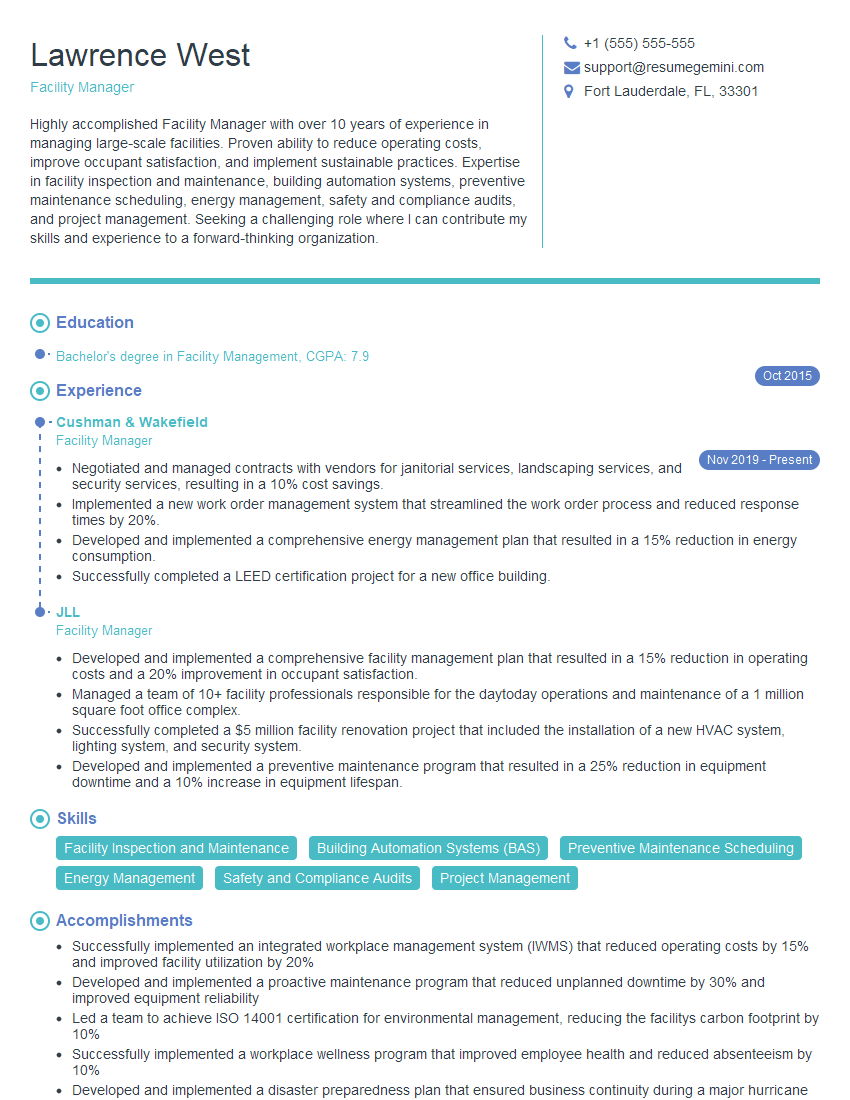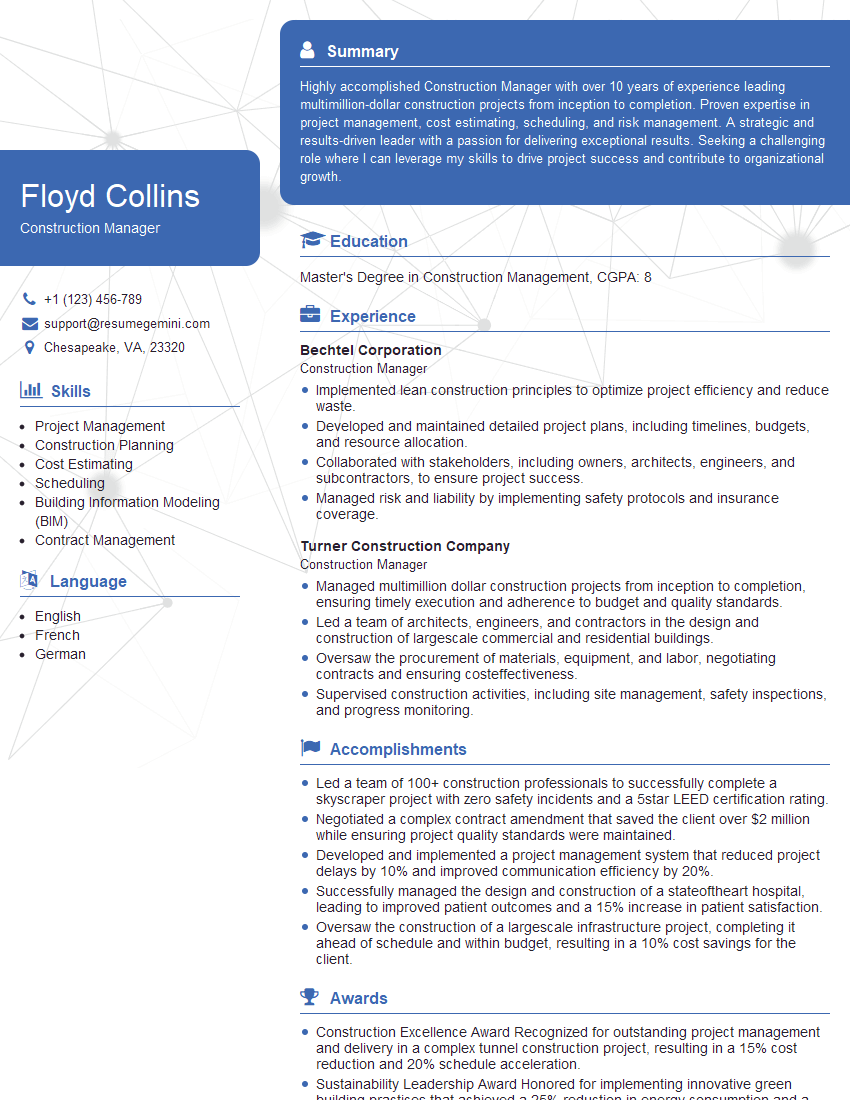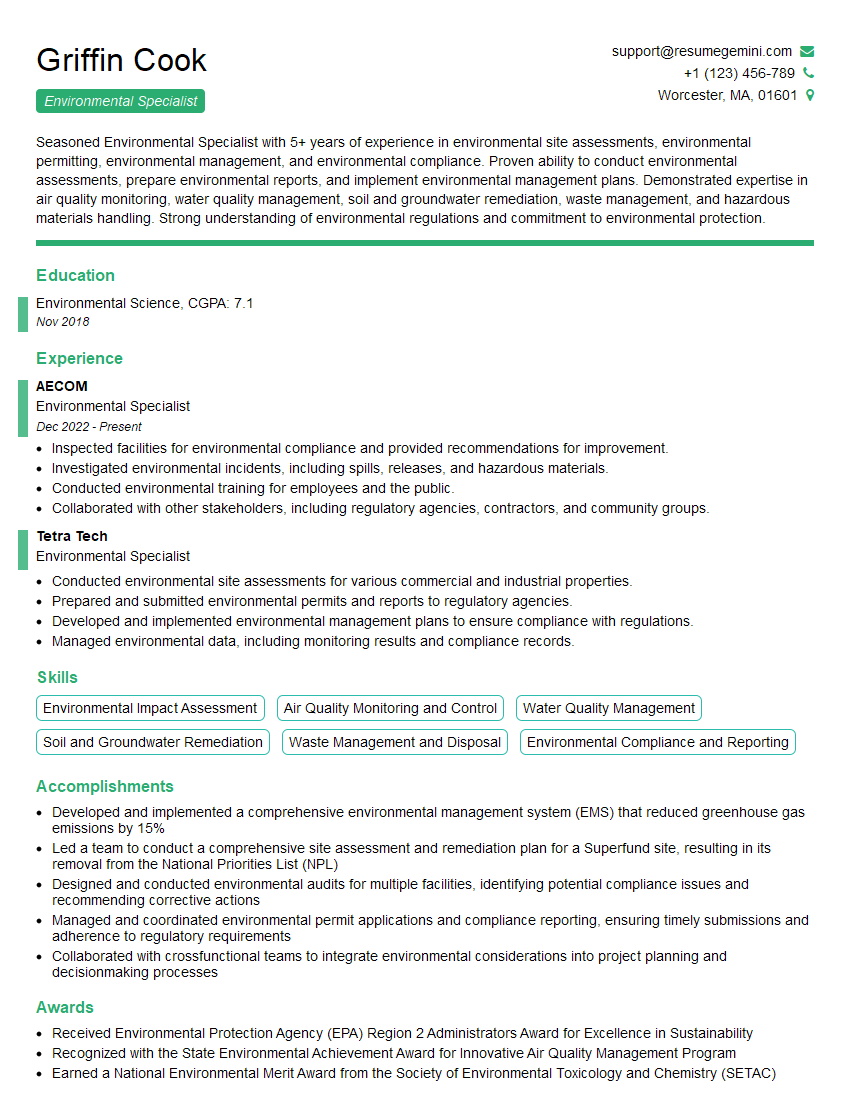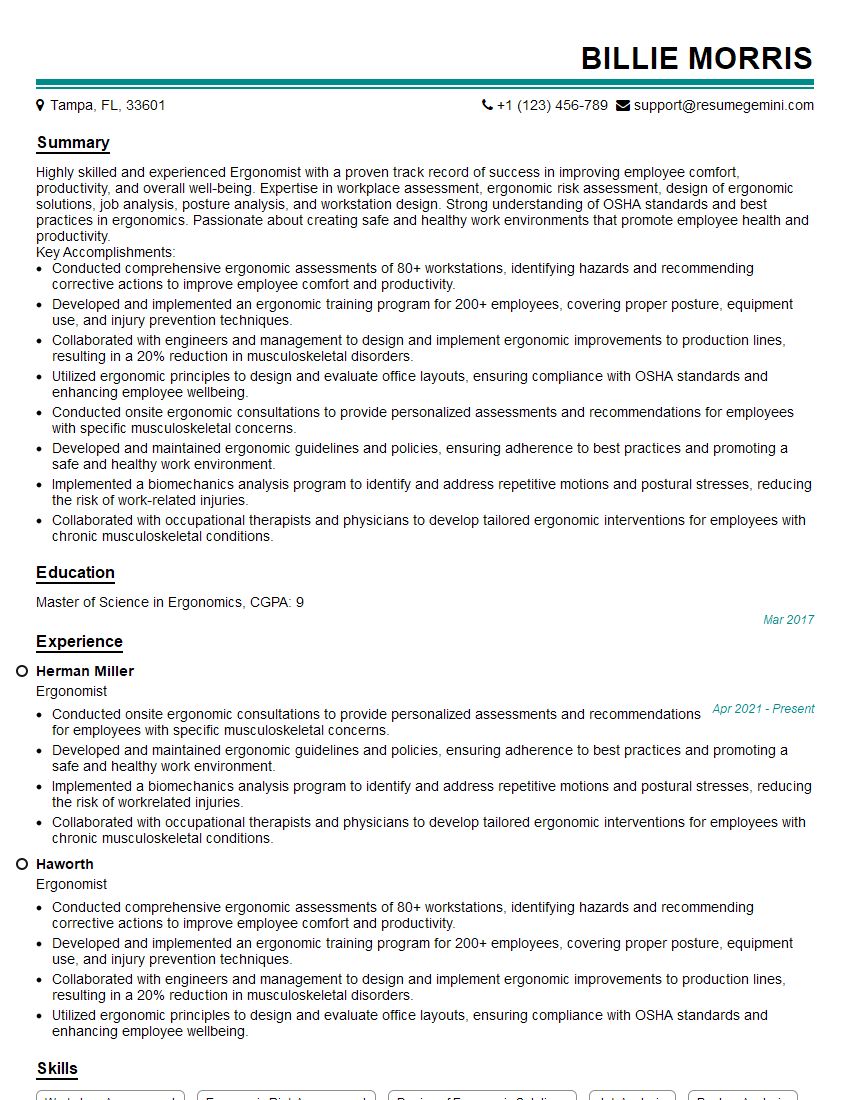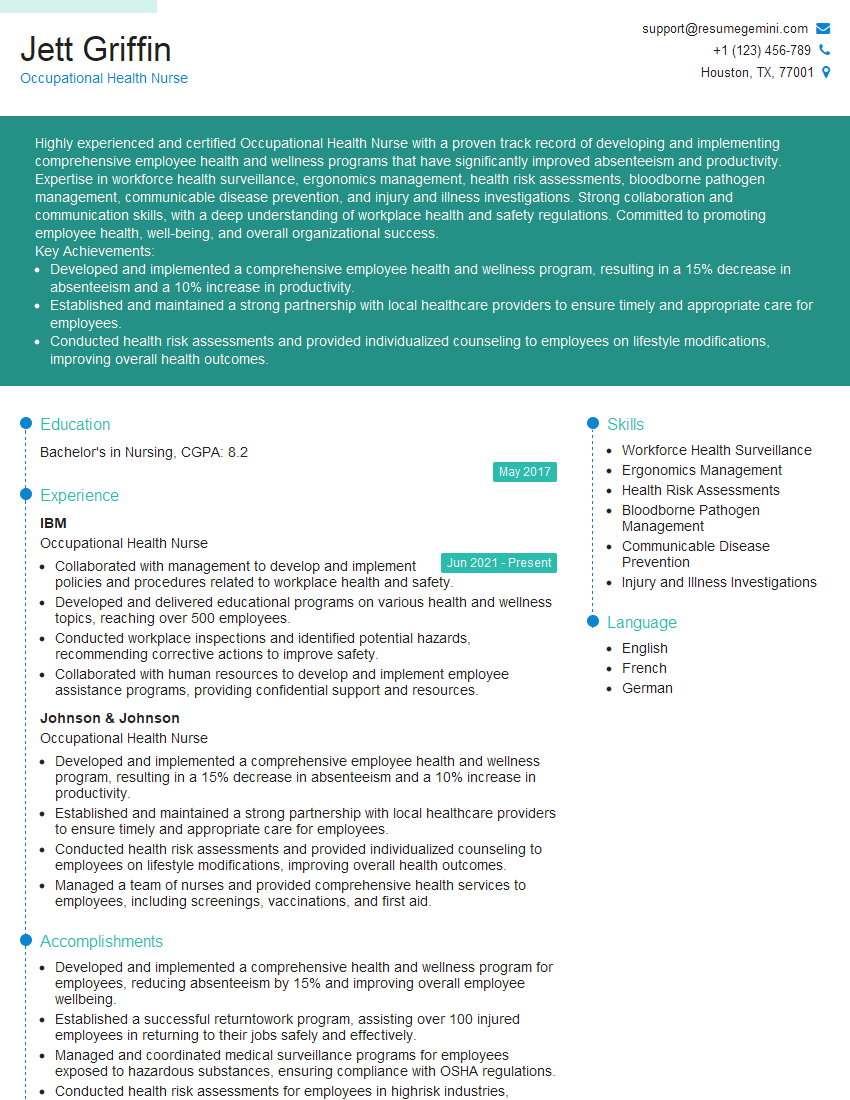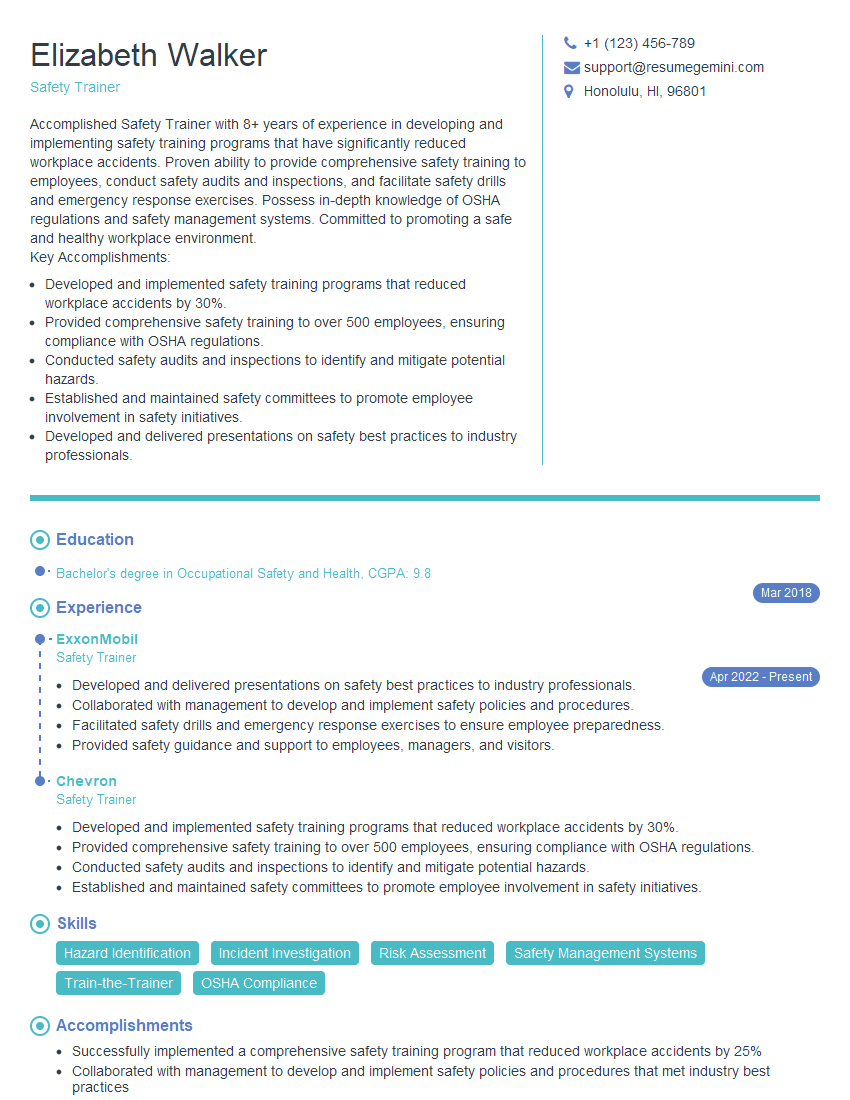Unlock your full potential by mastering the most common Worked in a safe and efficient manner interview questions. This blog offers a deep dive into the critical topics, ensuring you’re not only prepared to answer but to excel. With these insights, you’ll approach your interview with clarity and confidence.
Questions Asked in Worked in a safe and efficient manner Interview
Q 1. Describe your experience implementing safety protocols in a workplace.
Implementing safety protocols is paramount to a productive and incident-free workplace. My approach involves a multi-faceted strategy focusing on training, enforcement, and continuous improvement.
In my previous role at a manufacturing plant, I spearheaded the implementation of a new lockout/tagout (LOTO) procedure. This involved comprehensive training for all employees on the proper procedures for isolating and de-energizing equipment before maintenance. We used interactive simulations and hands-on training to ensure everyone understood the critical steps. We also introduced regular audits and inspections to verify compliance and identify areas for improvement. The result was a significant reduction in near-miss incidents related to machine operation.
Another example involved introducing a color-coded system for identifying hazardous materials. This simple, visual cue significantly reduced the risk of accidental exposure by clearly delineating storage locations and handling requirements. These improvements, documented and tracked through safety meetings and incident reports, improved overall safety culture within the facility.
Q 2. How do you identify and mitigate potential workplace hazards?
Identifying and mitigating workplace hazards requires a proactive and systematic approach. I typically employ a three-pronged strategy: hazard identification, risk assessment, and control implementation.
- Hazard Identification: This involves conducting regular workplace inspections, analyzing accident reports, and soliciting feedback from employees. Methods include checklists, job hazard analyses (JHAs), and safety audits. For example, during a routine inspection, I identified a tripping hazard due to loose cabling in a high-traffic area.
- Risk Assessment: Once hazards are identified, a risk assessment determines the likelihood and severity of potential harm. This often uses a matrix that combines probability and consequence to prioritize actions. The loose cabling, for instance, was assessed as a high-risk hazard due to its potential for serious injury.
- Control Implementation: This involves implementing measures to eliminate or reduce the identified risks. For the cabling hazard, we implemented immediate cable management solutions involving proper cable trays and labeling. Other control methods could include engineering controls (e.g., machine guarding), administrative controls (e.g., work permits), and personal protective equipment (PPE).
Q 3. Explain a time you improved workplace efficiency without compromising safety.
In a previous warehouse setting, we were facing challenges with order fulfillment times. To improve efficiency without compromising safety, we implemented a lean manufacturing approach focusing on process optimization.
Instead of making wholesale changes that could have introduced risks, we focused on small, incremental improvements. We reorganized the warehouse layout to optimize workflow, reducing unnecessary travel time for employees. We also implemented a new barcode scanning system for faster order picking and improved accuracy. This reduced the chance of errors and potential accidents due to rushing. Importantly, before implementing these changes, we conducted thorough risk assessments to identify and mitigate potential safety concerns associated with the new layout and processes. This included providing additional safety training on the use of the new scanning system and reinforcing existing safety protocols.
The results were impressive. We saw a 20% reduction in order fulfillment time with zero increase in accidents. This success highlighted the importance of systematic improvement rather than hasty changes. It proved that efficiency and safety are not mutually exclusive; rather, they are synergistic and can be enhanced through a careful, planned approach.
Q 4. What safety training have you received and how has it impacted your work?
Throughout my career, I’ve received extensive safety training, including OSHA 10-hour and 30-hour training, HAZWOPER (Hazardous Waste Operations and Emergency Response) training, and specific training on the equipment and processes used in my various roles.
The OSHA training provided a strong foundational knowledge of workplace safety regulations and best practices. HAZWOPER training equipped me to safely handle hazardous materials and respond to emergencies. Equipment-specific training was crucial for safely operating machinery and handling chemicals in my manufacturing roles. This training has significantly impacted my work by enabling me to identify and mitigate potential hazards proactively, make informed decisions concerning safety protocols, and effectively train others.
For example, my HAZWOPER certification allowed me to play a vital role in the safe cleanup of a chemical spill at my previous company, preventing further contamination and protecting employees. This experience underscored the practical value and importance of specialized safety training.
Q 5. Describe your experience with accident investigation and reporting procedures.
My experience with accident investigation and reporting involves following a structured process to determine root causes and prevent recurrence. This typically includes:
- Securing the scene: Ensuring the area is safe before commencing the investigation.
- Gathering information: Collecting data from witnesses, reviewing incident reports, and examining physical evidence.
- Analyzing the data: Identifying contributing factors and determining root causes using techniques like fault tree analysis or 5 Whys.
- Developing corrective actions: Implementing solutions to prevent similar incidents in the future.
- Reporting the findings: Documenting the entire process and submitting a comprehensive report to relevant stakeholders.
In one instance, a near-miss involving a forklift resulted in a thorough investigation. The analysis identified inadequate training as a significant contributing factor. As a result, we implemented a comprehensive forklift safety training program, including refresher courses for experienced operators. This proactive approach led to a substantial reduction in near-miss incidents involving forklifts.
Q 6. How do you ensure compliance with relevant safety regulations?
Ensuring compliance with safety regulations requires a multifaceted approach. I stay abreast of current regulations through continuous professional development, participation in industry events, and subscriptions to relevant publications.
Regular safety audits and inspections are key. These assessments compare our practices against regulatory requirements, identifying any discrepancies. We use checklists specific to each area and relevant regulations (OSHA, ANSI, etc.). Moreover, we maintain detailed records of training, inspections, and corrective actions. These records serve as evidence of our commitment to compliance and are crucial for potential audits or investigations.
For example, in a previous position, we proactively updated our safety procedures in response to a change in local fire codes. This involved updating our emergency action plan and conducting additional training for employees to ensure we remained fully compliant.
Q 7. How do you prioritize safety and efficiency in a high-pressure environment?
Prioritizing safety and efficiency in a high-pressure environment demands a structured approach. I use a risk-based prioritization system where safety always takes precedence.
While deadlines are important, compromising safety is never an option. I communicate clearly with my team, emphasizing that safety protocols are non-negotiable. We use clear communication channels and encourage open dialogue to address concerns. This fosters a culture where everyone feels empowered to halt operations if safety is at risk. We proactively address potential bottlenecks and anticipate challenges to prevent situations that might force compromises on safety.
For instance, during a period of tight deadlines, we discovered a potential shortcut that would have saved time but increased risk of equipment damage. Instead of taking the shortcut, we carefully planned a safer, although slightly slower, alternative. This resulted in a minor delay, but avoided a potentially much larger and more costly incident. This reinforced the value of prioritizing safety, even under pressure.
Q 8. Explain your understanding of risk assessment and control measures.
Risk assessment is the systematic process of identifying hazards and evaluating risks associated with those hazards. It involves determining the likelihood and severity of harm. Control measures are actions taken to eliminate or reduce these risks to an acceptable level. This is a crucial part of proactive safety management, aiming to prevent accidents before they happen.
A typical risk assessment follows these steps:
- Identify hazards: What could potentially cause harm? (e.g., slippery floors, heavy machinery, electrical hazards).
- Identify who might be harmed and how: Consider different groups of people (employees, visitors, contractors) and how they might be affected.
- Evaluate the risks: Assess the likelihood of harm occurring and the severity of the potential consequences (minor injury, serious injury, fatality). This is often represented in a risk matrix.
- Record the findings: Document all identified hazards, risks, and control measures.
- Review and update: Regularly review and update the risk assessment as work processes, equipment, or the environment changes.
Example: In a construction setting, a risk assessment might identify the hazard of working at heights. The risk evaluation might consider the likelihood of a fall and the severity of potential injuries. Control measures would include implementing fall protection systems (e.g., harnesses, guardrails), using scaffolding correctly, and providing appropriate training.
Q 9. How do you communicate safety concerns to your colleagues and supervisors?
Communicating safety concerns is paramount for maintaining a safe workplace. My approach is multifaceted and prioritizes clear, timely, and appropriate communication channels.
- Immediate concerns: For immediate dangers, I’ll alert colleagues directly and report to a supervisor immediately. If necessary, I’ll stop the work until the hazard is addressed.
- Potential concerns: For less immediate but still significant concerns, I’ll document the issue thoroughly, including photos or videos if appropriate, and report it through the established channels, such as a safety report form or email to the supervisor. I’ll clearly explain the potential risk and suggest potential solutions.
- Team communication: During team briefings or toolbox talks, I actively participate, sharing safety observations and lessons learned from near misses or incidents. This fosters a collaborative approach to safety.
- Formal communication: For formal issues, I participate in safety meetings and contribute to discussions regarding improvements and updates to safety procedures.
My communication style is direct, factual, and solution-oriented. I focus on the facts, avoiding emotional language. I value collaboration and seek feedback to ensure a shared understanding.
Q 10. Describe your experience with using personal protective equipment (PPE).
I have extensive experience using various types of PPE, ensuring their correct selection, use, and maintenance. This includes:
- Hard hats: Worn consistently in areas with overhead hazards, ensuring proper fit and condition.
- Safety glasses/goggles: Used whenever there’s a risk of eye injuries from flying debris, chemicals, or radiation.
- Hearing protection: Employed in high-noise environments, choosing appropriate earplugs or muffs based on the noise level.
- Gloves: Selected based on the task and potential hazards (e.g., cut-resistant gloves for handling sharp objects, chemical-resistant gloves for handling hazardous materials).
- Respiratory protection: Used when working with hazardous substances or in areas with poor air quality. Proper fit testing and training are crucial.
- High-visibility clothing: Worn in areas with traffic or poor visibility to ensure I am seen.
Before using any PPE, I always inspect it for damage and ensure it fits correctly. I promptly replace any damaged or worn-out equipment and adhere to all relevant training and guidelines.
Q 11. How do you ensure the safe use and maintenance of equipment and machinery?
Safe equipment use and maintenance are fundamental to workplace safety. My approach involves:
- Pre-use inspections: Before operating any equipment or machinery, I thoroughly inspect it for any signs of damage, wear, or malfunction. I will not operate equipment if it’s unsafe.
- Following operating procedures: I strictly adhere to all manufacturer’s instructions, safety guidelines, and company procedures for the operation of any equipment.
- Reporting defects: I immediately report any defects or malfunctions to my supervisor, ensuring the equipment is taken out of service until repaired. I make sure to document everything.
- Proper shutdown procedures: I always follow the correct shutdown procedures to prevent accidents and damage.
- Maintenance and cleaning: I contribute to the cleanliness and organization of the work area and assist in routine maintenance tasks where appropriate, following all safety protocols.
Example: Before operating a forklift, I would check the tires, hydraulic fluid levels, brakes, and horn. If any issues are found, I would report them immediately and not use the forklift until repaired.
Q 12. How do you contribute to a positive safety culture in the workplace?
A positive safety culture is built on shared values, responsibilities, and commitment. I contribute by:
- Leading by example: I consistently demonstrate safe work practices and encourage my colleagues to do the same.
- Active participation in safety initiatives: I actively participate in safety meetings, training, and toolbox talks.
- Reporting near misses and hazards: I promptly report any near misses or potential hazards, however small, promoting a proactive approach to safety.
- Supporting and encouraging colleagues: I support and encourage colleagues to follow safety procedures and report any concerns.
- Promoting open communication: I foster an environment of open communication where everyone feels comfortable raising safety concerns without fear of retribution.
A strong safety culture isn’t just about rules; it’s about a collective commitment to caring for each other and working safely.
Q 13. Explain a time you identified a safety deficiency and took action to rectify it.
During a project involving working at heights, I noticed that the safety harness provided did not have a proper fall arrest system. This was a significant safety deficiency, as a fall could have resulted in serious injury or fatality. I immediately reported this to my supervisor, highlighting the potential risk. The supervisor quickly took action, stopping the work at height until appropriate harnesses with fall arrest systems were procured and provided.
My steps included:
- Identify the deficiency: Observed the lack of a proper fall arrest system on the provided harnesses.
- Assess the risk: Recognized the high potential for serious injury or death if a fall occurred.
- Report the deficiency: Immediately informed my supervisor, providing detailed information about the problem.
- Collaborate on a solution: Worked with the supervisor to implement a solution, ensuring appropriate harnesses were obtained before work resumed.
- Verify the solution: Confirmed that the new harnesses met safety standards before work recommenced at height.
This situation reinforced the importance of proactive safety checks and the necessity for clear communication channels for reporting potential hazards.
Q 14. How do you measure and track workplace safety performance?
Workplace safety performance can be measured and tracked through various methods:
- Incident reporting and analysis: Tracking the number and types of accidents, near misses, and incidents. Analyzing trends to identify areas needing improvement.
- Safety audits: Conducting regular safety audits to assess compliance with safety procedures and identify potential hazards.
- Safety inspections: Regularly inspecting work areas, equipment, and machinery to ensure they are safe and properly maintained.
- Employee safety training records: Maintaining records of employee safety training to ensure everyone is adequately trained.
- Safety observation programs: Implementing safety observation programs where employees report near misses and unsafe conditions.
- Key Performance Indicators (KPIs): Tracking KPIs like the Lost Time Injury Frequency Rate (LTIFR), Total Recordable Incident Rate (TRIR), and other relevant metrics to monitor progress.
The data gathered is used to create safety reports, identifying trends and areas needing improvement. This allows us to develop targeted safety interventions and continually enhance our safety program.
Q 15. Describe your experience with emergency response procedures.
Emergency response procedures are critical for minimizing damage and ensuring safety during unexpected events. My experience encompasses various scenarios, from minor incidents to major emergencies. I’ve participated in comprehensive training programs covering fire safety, evacuation procedures, first aid, and handling of hazardous spills.
For example, during a recent chemical spill incident, my immediate actions involved activating the emergency response plan, contacting emergency services, and implementing containment measures as per our company’s Standard Operating Procedures (SOPs). I also ensured the safe evacuation of personnel from the affected area, coordinating with security and first responders to ensure efficient and safe operations. We successfully mitigated the spill’s impact, minimizing environmental damage and preventing injuries. Post-incident, I participated in the thorough investigation and root cause analysis to enhance our future preparedness and prevent recurrences.
My experience also includes regular drills and simulations, which are crucial for maintaining proficiency and team coordination. These exercises ensure we are prepared to respond effectively and efficiently to a wide range of situations.
Career Expert Tips:
- Ace those interviews! Prepare effectively by reviewing the Top 50 Most Common Interview Questions on ResumeGemini.
- Navigate your job search with confidence! Explore a wide range of Career Tips on ResumeGemini. Learn about common challenges and recommendations to overcome them.
- Craft the perfect resume! Master the Art of Resume Writing with ResumeGemini’s guide. Showcase your unique qualifications and achievements effectively.
- Don’t miss out on holiday savings! Build your dream resume with ResumeGemini’s ATS optimized templates.
Q 16. How do you ensure the safe handling of hazardous materials?
Safe handling of hazardous materials is paramount. It starts with a thorough understanding of the Material Safety Data Sheets (MSDS) for every material used. This provides crucial information on potential hazards, safe handling practices, and emergency response procedures. I strictly adhere to all relevant regulations, including OSHA guidelines and company-specific SOPs.
My approach emphasizes the use of appropriate Personal Protective Equipment (PPE), such as gloves, respirators, and eye protection, selected based on the specific hazard. I also ensure proper storage, labeling, and segregation of hazardous materials to prevent accidental mixing or exposure. Furthermore, I’m vigilant about proper waste disposal methods to minimize environmental impact. For instance, when handling corrosive chemicals, I always ensure that the appropriate spill kits and neutralization agents are readily accessible and utilized correctly in the event of an accidental spill.
Regular inspections of storage areas and equipment are essential to identify and rectify any potential safety issues proactively. This prevents hazardous situations from developing. Safety is always my top priority.
Q 17. How do you balance productivity targets with safety regulations?
Balancing productivity targets with safety regulations is not a compromise; it’s a synergistic approach. Productivity is significantly enhanced when safety is prioritized. Shortcuts in safety can lead to accidents, delays, and increased costs in the long run.
My approach involves proactive risk assessment. Before commencing any task, I identify potential hazards and develop a safe work plan that addresses them. This plan includes specifying necessary PPE, outlining safe work procedures, and designating safety personnel, where appropriate. Technology can play a crucial role, too. Using real-time monitoring systems and data analytics can help optimize workflows while ensuring adherence to safety protocols. Clear communication with team members, supervisors, and management is paramount to ensure everyone understands and adheres to safety guidelines. For example, a specific project might require overtime. Before approving that overtime, I’d ensure that fatigue won’t compromise safety and create a plan to ensure appropriate breaks and rest periods.
Ultimately, a culture of safety breeds efficiency and increases productivity by reducing incidents, avoiding downtime, and fostering a confident and productive workforce.
Q 18. Describe a situation where you had to adapt your work methods to ensure safety.
During a project involving the installation of heavy machinery, the original plan involved using a crane that would’ve required working close to a high-voltage power line. Recognizing the significant risk of electrocution, I proposed an alternative method. We utilized a smaller, more maneuverable crane positioned further away from the power line, and supplemented with a smaller lifting device for the final placement of the machinery. This method eliminated the immediate danger and allowed us to complete the installation without compromising safety. We documented the changes in the project plan for future reference and improved our risk assessment process to prevent similar situations in the future.
Q 19. How do you use technology to improve safety and efficiency?
Technology plays a significant role in enhancing safety and efficiency. We utilize various software and hardware to improve our processes. For example, we employ wearable sensors that monitor workers’ vital signs and location during potentially hazardous tasks. These real-time data alerts us to potential issues such as falls or fatigue, allowing for immediate intervention. We also use drone technology to inspect hard-to-reach areas, reducing the need for workers to be in hazardous environments. Safety management software helps track safety incidents, training records, and compliance with regulations. This data assists in identifying areas for improvement and streamlining safety procedures. Data analytics allow us to identify trends and patterns related to accidents, facilitating a proactive approach to safety.
Q 20. How do you train others on safe work practices?
Training others on safe work practices is a crucial aspect of my role. I use a blended learning approach that combines classroom instruction, hands-on training, and on-the-job mentoring. I begin with clear explanations of relevant regulations and safety procedures, utilizing visual aids, presentations, and practical demonstrations. Hands-on training allows individuals to practice safe techniques in a controlled environment, which builds confidence and proficiency. On-the-job mentoring provides personalized guidance and feedback, ensuring that workers understand and apply learned skills correctly. Regular refresher courses and safety audits are essential to reinforce learning and identify any areas needing improvement. I also encourage a culture of open communication where workers feel comfortable asking questions and reporting potential hazards.
Q 21. What are some common workplace safety hazards and how do you address them?
Common workplace safety hazards vary across industries, but some common examples include slips, trips, and falls; exposure to hazardous materials; electrical hazards; and ergonomic risks. Addressing these requires a multifaceted approach.
- Slips, trips, and falls: Regular cleaning and maintenance of walkways, proper lighting, appropriate footwear, and anti-slip surfaces are crucial.
- Hazardous materials: Proper handling, storage, labeling, and use of PPE are essential as discussed previously.
- Electrical hazards: Lockout/tagout procedures for equipment maintenance, regular inspection of electrical equipment, and proper grounding are critical.
- Ergonomic risks: Proper workstation setup, regular breaks, and job rotation can help prevent musculoskeletal injuries. Training and education are key to raising awareness of these hazards and promoting safe work practices.
Implementing a robust safety management system, involving regular inspections, risk assessments, and proactive incident reporting, is crucial to mitigating these hazards and creating a safe work environment.
Q 22. Describe your experience with conducting safety inspections.
Conducting thorough safety inspections is paramount to maintaining a safe work environment. My approach involves a systematic process combining pre-planned checklists with keen observational skills. I begin by reviewing relevant safety regulations and procedures specific to the area being inspected. Then, I conduct a visual inspection, paying close attention to potential hazards like exposed wires, damaged equipment, improper storage of materials, and housekeeping issues. I also engage in active observation, looking for unsafe behaviors or practices. For example, I once identified a potential fall hazard during a routine inspection because a worker was using a ladder that was not properly secured. After the inspection, I meticulously document all findings, including photos or videos where appropriate, and categorize them by severity. This detailed report allows for prioritized corrective actions and ensures accountability.
This process isn’t just about ticking boxes; it’s about proactively identifying and mitigating risks before an incident occurs. It requires a blend of technical knowledge, attention to detail, and a genuine commitment to worker safety.
Q 23. How do you monitor and evaluate the effectiveness of safety programs?
Monitoring and evaluating safety program effectiveness is an ongoing process that requires a multi-faceted approach. I use a combination of leading and lagging indicators. Lagging indicators are the results, such as the number of accidents or near misses. Leading indicators, on the other hand, measure preventative actions, like the number of safety training hours completed, the frequency of safety inspections, and employee participation in safety initiatives. By tracking both, we gain a comprehensive understanding of the program’s success.
For instance, a decrease in reported near misses suggests the program is effectively changing employee behavior, even if the number of accidents hasn’t yet decreased. Regularly analyzing this data helps identify areas for improvement. We use this data to refine existing procedures, introduce new training, or address any systemic issues that might be contributing to safety concerns. Furthermore, regular feedback sessions and surveys with employees provide valuable insight into their perceptions of safety and the effectiveness of the programs.
Q 24. How do you handle conflicts between safety and productivity goals?
Balancing safety and productivity is a critical challenge in many workplaces, and it’s not about choosing one over the other. Instead, it’s about recognizing that true productivity relies on a safe environment. Conflicts often arise from perceived time constraints or increased costs associated with safety measures. My approach is to demonstrate how investing in safety actually improves productivity in the long run.
For example, if a project manager wants to expedite a task that might compromise safety protocols, I present data showing that workplace injuries lead to lost time, increased medical costs, and decreased morale. I then work collaboratively to find solutions that enhance both safety and efficiency. This might involve introducing more efficient safety equipment, implementing new procedures, or providing additional training to improve workflow.
Ultimately, it’s about building a culture where safety is not seen as an obstacle but as a fundamental component of productivity.
Q 25. Explain your approach to creating a safe and efficient work environment.
Creating a safe and efficient work environment is a holistic endeavor that starts with a strong safety culture. This involves several key elements:
- Risk Assessment: Conducting regular and thorough risk assessments to identify and mitigate potential hazards.
- Training & Education: Providing comprehensive safety training programs tailored to different job roles and regularly updating them.
- Clear Procedures & Communication: Establishing clear, concise, and easily accessible safety procedures and protocols, along with effective communication channels to ensure everyone understands them.
- Employee Engagement: Actively encouraging employee participation in safety initiatives through feedback, suggestions, and safety committees.
- Proper Equipment & Maintenance: Ensuring that all equipment is properly maintained, inspected regularly, and in good working order.
- Ergonomics: Implementing ergonomic principles to minimize the risk of musculoskeletal injuries.
- Housekeeping: Maintaining a clean and organized workplace to reduce trip hazards and prevent accidents.
By implementing these measures, I aim to foster a work environment where safety is not just a policy, but a shared value and a continuous improvement process.
Q 26. How do you stay current with changes in safety regulations and best practices?
Staying current with safety regulations and best practices is crucial in this ever-evolving field. I achieve this through several avenues:
- Professional Organizations: Active membership in professional safety organizations such as [Mention relevant organizations, e.g., OSHA, etc.], providing access to industry news, publications, and networking opportunities.
- Conferences & Workshops: Attending industry conferences and workshops to learn about new technologies, regulations, and best practices.
- Online Resources: Utilizing online resources and databases to access updated safety standards and regulations.
- Regulatory Websites: Regularly reviewing relevant governmental websites, such as OSHA’s website, for updates on regulations and enforcement initiatives.
- Industry Publications: Subscribing to and regularly reading industry publications and journals.
This continuous learning ensures that my knowledge and practices remain aligned with current standards, contributing to a safer and more efficient work environment.
Q 27. Describe your experience with developing and implementing safety procedures.
Developing and implementing safety procedures involves a structured approach. It starts with identifying potential hazards through thorough risk assessments, as mentioned previously. Next, I work to develop detailed, step-by-step procedures to mitigate those hazards. These procedures should be clear, concise, and easy to understand by all employees.
For instance, when developing a procedure for operating a specific piece of machinery, I would include details on pre-operational checks, safe operating procedures, emergency shut-off procedures, and post-operational checks. The procedure is then tested, reviewed and revised based on feedback from employees and practical application. Finally, I ensure proper training is provided to all employees on the new procedures, along with clear communication channels for reporting incidents or near misses.
Throughout this process, I maintain a focus on practicality and clarity. The goal isn’t to create a complex document, but to create a clear guide that employees can easily follow and understand.
Q 28. How do you promote continuous improvement in safety and efficiency?
Promoting continuous improvement in safety and efficiency is an ongoing commitment. I utilize several strategies:
- Regular Safety Audits: Conducting regular internal audits to identify areas for improvement and address any shortcomings.
- Incident Investigation: Thoroughly investigating all incidents and near misses to understand root causes and implement corrective actions to prevent recurrence.
- Data Analysis: Analyzing safety data to track trends, identify patterns, and highlight areas requiring attention.
- Employee Feedback: Encouraging open communication and actively seeking feedback from employees to identify potential hazards and areas for improvement.
- Benchmarking: Comparing performance against industry best practices to identify areas where improvements can be made.
- Safety Meetings and Training: Regularly conducting safety meetings and refresher training to reinforce procedures and address current issues.
Continuous improvement is not a destination but a journey. By consistently implementing these strategies, we can create a more proactive and responsive safety culture that leads to a safer and more efficient workplace for everyone.
Key Topics to Learn for “Worked in a Safe and Efficient Manner” Interview
- Safety Regulations & Compliance: Understanding relevant safety regulations, company policies, and procedures related to your field. This includes knowing how to identify and report hazards.
- Efficient Work Practices: Demonstrate knowledge of time management techniques, prioritization skills, and workflow optimization strategies. Be prepared to discuss examples where you improved efficiency.
- Risk Assessment & Mitigation: Explain your understanding of identifying potential risks, assessing their severity, and implementing preventative measures. Provide examples of how you’ve proactively addressed safety concerns.
- Teamwork & Communication: Highlight your ability to collaborate effectively with colleagues to maintain a safe and productive work environment. Discuss how you communicate safety concerns and best practices.
- Problem-Solving & Adaptability: Describe instances where you encountered unexpected challenges or safety issues and how you adapted your approach to resolve them efficiently and safely.
- Equipment & Tool Usage: If applicable, demonstrate your proficiency in using specific equipment or tools safely and correctly. Highlight your training and experience in this area.
- Documentation & Reporting: Discuss your experience in accurately documenting safety procedures, incidents, and near misses. Explain your understanding of incident reporting protocols.
Next Steps
Mastering the ability to demonstrate your commitment to safety and efficiency is crucial for career advancement. It showcases responsibility, professionalism, and a proactive approach to problem-solving – qualities highly valued by employers. To increase your job prospects, creating an ATS-friendly resume is essential. ResumeGemini can help you build a professional resume that highlights these key skills and experiences. We provide examples of resumes tailored to showcase “Worked in a safe and efficient manner,” helping you present yourself effectively to potential employers.
Explore more articles
Users Rating of Our Blogs
Share Your Experience
We value your feedback! Please rate our content and share your thoughts (optional).
What Readers Say About Our Blog
Hi, I have something for you and recorded a quick Loom video to show the kind of value I can bring to you.
Even if we don’t work together, I’m confident you’ll take away something valuable and learn a few new ideas.
Here’s the link: https://bit.ly/loom-video-daniel
Would love your thoughts after watching!
– Daniel
This was kind of a unique content I found around the specialized skills. Very helpful questions and good detailed answers.
Very Helpful blog, thank you Interviewgemini team.
